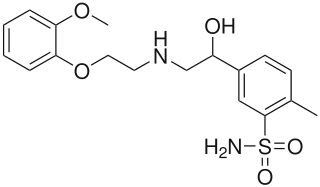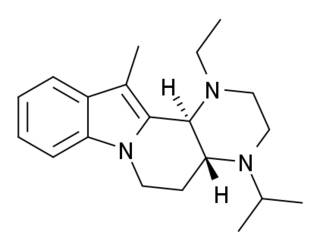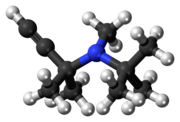Antihypertensives are a class of drugs that are used to treat hypertension. Antihypertensive therapy seeks to prevent the complications of high blood pressure, such as stroke and myocardial infarction. Evidence suggests that reduction of the blood pressure by 5 mmHg can decrease the risk of stroke by 34%, of ischaemic heart disease by 21%, and reduce the likelihood of dementia, heart failure, and mortality from cardiovascular disease. There are many classes of antihypertensives, which lower blood pressure by different means. Among the most important and most widely used medications are thiazide diuretics, calcium channel blockers, ACE inhibitors, angiotensin II receptor antagonists (ARBs), and beta blockers.

Reserpine is a drug that is used for the treatment of high blood pressure, usually in combination with a thiazide diuretic or vasodilator. Large clinical trials have shown that combined treatment with reserpine plus a thiazide diuretic reduces mortality of people with hypertension. Although the use of reserpine as a solo drug has declined since it was first approved by the FDA in 1955, a review recommends use of reserpine and a thiazide diuretic or vasodilator in patients who do not achieve adequate lowering of blood pressure with first-line drug treatment alone. The reserpine-hydrochlorothiazide combo pill was the 17th most commonly prescribed of the 43 combination antihypertensive pills available In 2012.

Doxazosin, sold under the brand names Cardura among others, is a medication used to treat symptoms of an enlarged prostate and high blood pressure. For high blood pressure, it is a less preferred option. It is taken by mouth.
The rubiscolins are a group of opioid peptides that are formed during digestion of the ribulose bisphosphate carboxylase/oxygenase (Rubisco) protein from spinach leaves. These peptides have much in common with the better-known gluten exorphins.

Moxonidine (INN) is a new-generation alpha-2/imidazoline receptor agonist antihypertensive drug licensed for the treatment of mild to moderate essential hypertension. It may have a role when thiazides, beta-blockers, ACE inhibitors, and calcium channel blockers are not appropriate or have failed to control blood pressure. In addition, it demonstrates favourable effects on parameters of the insulin resistance syndrome, apparently independent of blood pressure reduction. It is also a growth hormone releaser. It is manufactured by Solvay Pharmaceuticals under the brand name Physiotens & Moxon.

Guanabenz is an alpha agonist of the alpha-2 adrenergic receptor that is used as an antihypertensive drug. It is used to treat high blood pressure (hypertension).

Rilmenidine is a prescription medication for the treatment of hypertension. It is marketed under the brand names Albarel, Hyperium, Iterium and Tenaxum.

Zofenopril (INN) is a medication that protects the heart and helps reduce high blood pressure. It is an angiotensin-converting enzyme (ACE) inhibitor.

Manidipine is a calcium channel blocker that is used clinically as an antihypertensive.

Urapidil is a sympatholytic antihypertensive drug. It acts as an α1-adrenoceptor antagonist and as an 5-HT1A receptor agonist. Although an initial report suggested that urapidil was also an α2-adrenoceptor agonist, this was not substantiated in later studies that demonstrated it was devoid of agonist actions in the dog saphenous vein and the guinea-pig ileum. Unlike some other α1-adrenoceptor antagonists, urapidil does not elicit reflex tachycardia, and this may be related to its weak β1-adrenoceptor antagonist activity, as well as its effect on cardiac vagal drive. Urapidil is currently not approved by the U.S. Food and Drug Administration, but it is available in Europe.

Amosulalol (INN) is an anti-hypertensive drug. It has much higher affinity for alpha-1 adrenergic receptors than for beta adrenergic receptors.

Monatepil is a calcium channel blocker and α1-adrenergic receptor antagonist used as an antihypertensive.

Tolonidine is an antihypertensive.

Bietaserpine (INN), or 1-diaminoethylreserpine, is a derivative of reserpine used as an antihypertensive agent. Like reserpine, bietaserpine is a VMAT inhibitor.
Adimolol (MEN-935) is antihypertensive agent which acts as a non-selective α1-, α2-, and β-adrenergic receptor antagonist.

Atiprosin (AY-28,228) is an antihypertensive agent which acts as a selective α1-adrenergic receptor antagonist. It also possesses some antihistamine activity, though it is some 15-fold weaker in this regard than as an alpha blocker. It was never marketed.

1-Phenylpiperazine is a simple chemical compound featuring a phenyl group bound to a piperazine ring. The suffix ‘-piprazole’ is sometimes used in the names of drugs to indicate they belong to this class.

Tiamenidine is an imidazoline compound that shares many of the pharmacological properties of clonidine. It acts as a centrally-acting α1 and α2 adrenergic receptor antagonist. In hypertensive volunteers, like clonidine, it significantly increased sinus node recovery time and lowered cardiac output. It was marketed by Sanofi-Aventis under the brand name Sundralen for the management of essential hypertension.

Metazosin is an antihypertensive alpha-adrenergic antagonist.

Quinazosin is an antihypertensive adrenoreceptor antagonist.


















